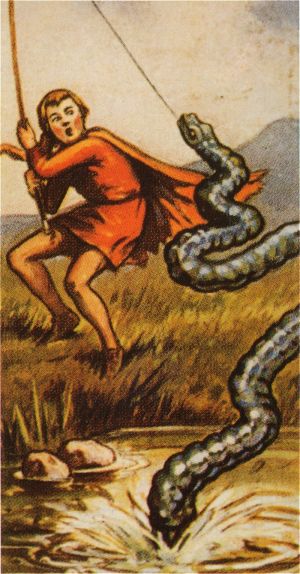
The Lambton Worm
Dragons, known historically as "worms" (or "wyrms") in Old English, are a very popular subject of folklore and have been for centuries. They typically match the description of large serpent or snake, if not your traditional dragon. The Lambton Worm of County Durham is a story that dates back to medieval times and a young man named John Lambton.
Lambton was the heir to of the Lambton Estate and, being a bit of a rebel, had decided to skip church service in order to go fishing at the River Wear. This was in ignorance of the warnings of a mysterious old man, who told him no good would come of skipping church. For a long time his fishing trip is fruitless -- until he reels in a very strange, serpentine fish, with the head of a salamander and nine holes on either side of its skull.
Afraid of his catch, Lambton turned to the old man again, who advised him against returning the strange beast to the river. Instead, Lambton casts the creature into a nearby well, in doing so casting it from his mind. Eventually, Lambton grows up, and leaves to fight on the Crusades.
The worm was left for many years, growing in the dark and dank depths of the well, poisoning its water... until eventually, the beast erupted from its well and began to terrorize the lands around it. Livestock and local children were lost to the Lambton Worm's vicious appetite. Many knights travelled and fought in vain to slay the beast, for any time the worm's tail was severed, it would easily re-attach itself together.
 The Lambton Worm is known to have taken residence on Penshaw Hill, where the Penshaw Monument now stands. It is said to have been so large that it could wrap itself at least thrice around this large hill (although the 19th century song by Leurmane states ten times!), and did so to rest.
The Lambton Worm is known to have taken residence on Penshaw Hill, where the Penshaw Monument now stands. It is said to have been so large that it could wrap itself at least thrice around this large hill (although the 19th century song by Leurmane states ten times!), and did so to rest.
When Lambton returns to his homeland he finds it in ruin and, upon realising the harbinger of this destruction, vows vengeance upon the Lambton Worm. He turns to the aid of a local witch, who first reminds Lambton that he is the one responsible for this great tragedy. He is advised to go to the blacksmith and have his armour reinforced with razor-sharp spear points, then attack the worm as it rests wrapped around the great rock of Penshaw Hill by the edge of the River Wear. The witch also warns him however that should he succeed, he must kill the first living thing he sees after the Worm, or his family will fall under a wicked curse.
 Lambton follows her advice, and is able to slay the Lambton Worm; when the serpent attempted to restrain Lambton by coiling itself around him, the sharp edges of his armour would pierce and slice the worm's body to pieces. Furthermore, fighting the Worm by the water's edge meant any parts of it that were severed would be swept downstream, preventing it from reattaching these parts.
Lambton follows her advice, and is able to slay the Lambton Worm; when the serpent attempted to restrain Lambton by coiling itself around him, the sharp edges of his armour would pierce and slice the worm's body to pieces. Furthermore, fighting the Worm by the water's edge meant any parts of it that were severed would be swept downstream, preventing it from reattaching these parts.
Craftily, Lambton had arranged for a hunting hound to be released on his signal after the death of the Lambton Worm, so that he could kill it and lift the curse. However, swept along by the rush of victory, his father forgets about the plan -- he runs out himself to greet his son, and Lambton couldn't muster the heart to kill his own father...
And so, the curse stained the family. For nine generations, no heir would die peacefully -- and to an extent, this was actually true! For at least three generations, the heirs of Lambton went on to die very unpeacefully indeed. In the first generation, Robert Lambton drowned at Newrig. In the second, Sir William Lambton (a Colonel of Foot) was killed at Marson Moor. In the third, William Lambton died in battle at Wakefield. In the ninth generation, Henry Lambton died in his carriage crossing the Lambton Bridge.



 The Lambton Worm is known to have taken residence on
The Lambton Worm is known to have taken residence on  Lambton follows her advice, and is able to slay the Lambton Worm; when the serpent attempted to restrain Lambton by coiling itself around him, the
Lambton follows her advice, and is able to slay the Lambton Worm; when the serpent attempted to restrain Lambton by coiling itself around him, the